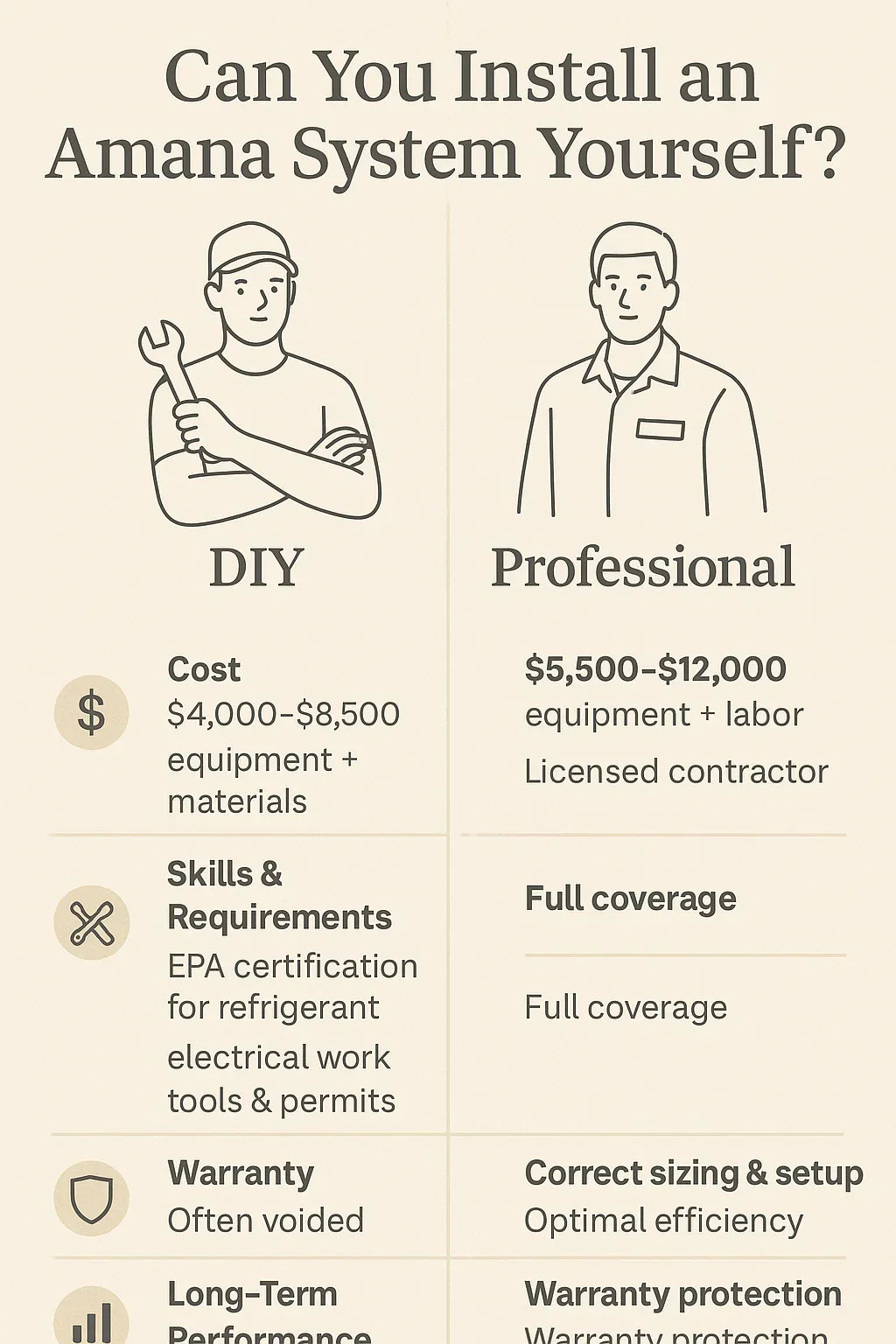🏠 Introduction: Why This Question Matters
The rising cost of home improvements has more homeowners asking the big question:
"Can I save thousands by installing my HVAC system myself?"
On the surface, buying an Amana system online and doing the work yourself might seem like a straightforward way to cut costs. But HVAC installation is not like swapping a faucet or adding insulation — it’s a specialized job that involves refrigerants, high-voltage electrical work, and precise airflow calibration.
The decision isn’t just about skill — it’s about safety, legality, system performance, and warranty protection.
In this guide, we’ll walk through what’s really involved in an Amana HVAC install, the risks and requirements for DIY, and why professional installation is often the smarter long-term investment.
🛠 What’s Involved in an Amana HVAC Installation
Installing an Amana HVAC system — whether it’s a central AC, heat pump, or gas furnace — requires multiple stages of work:
1. Equipment Handling
-
Amana units can weigh 150–350 lbs.
-
Moving them without the right lifting gear risks injury or damage.
2. Refrigerant Line Connection
-
Most Amana cooling systems use R-410A or, in 2025+ models, R-32.
-
Lines must be vacuumed to remove moisture, brazed or flared correctly, and charged to precise manufacturer specifications (EPA Refrigerant Guidelines).
3. Electrical Wiring and Breaker Requirements
-
High-voltage connections (208–240V) are standard.
-
Breaker size, wire gauge, and disconnect placement must meet National Electrical Code (NEC) standards.
4. Ductwork Compatibility and Modifications
-
Poorly sized ducts cause efficiency loss, noise, and uneven temperatures.
-
Modifications may involve sheet metal work, sealing, or adding returns.
5. Control and Thermostat Setup
-
Amana ComfortBridge™ systems require proper communication wiring.
-
Incorrect setup can lock out features or cause system errors.
📋 Legal & Regulatory Considerations
EPA Section 608 Certification
Under U.S. law, anyone handling refrigerants must hold an EPA Section 608 Certification. Without it, you cannot legally purchase or charge refrigerant in most states.
Local Permits and Inspections
Many cities require a permit for HVAC replacement, which triggers:
-
Safety inspections
-
Code compliance checks
-
Possible rework if standards aren’t met.
Home Insurance Implications
If a fire, refrigerant leak, or electrical failure occurs due to unpermitted work, your home insurance may deny coverage.
⚠ Risks of DIY Installation
1. Safety Hazards
-
High-voltage electrocution
-
Refrigerant burns or asphyxiation risk
-
Lifting injuries
2. System Damage
-
Incorrect refrigerant charge can cause compressor failure.
-
Poor brazing can leak refrigerant and void warranty coverage.
3. Performance Inefficiency
Even a 5% duct leak can cut HVAC efficiency by 20–30% (EnergyStar Duct Sealing Guide).
💼 Professional Installation Advantages
1. Proper Load Calculation (Manual J)
Amana dealers use ACCA Manual J to size equipment accurately for your home (ACCA Manual J Guide).
2. Code and Permit Compliance
Licensed installers handle paperwork and coordinate inspections.
3. Warranty Protection
Amana’s Lifetime Compressor Limited Warranty is only valid with professional installation.
4. Post-Install Support
Professionals provide:
-
System commissioning reports
-
First-year maintenance
-
Emergency repair priority
💰 Cost Comparison: DIY vs. Pro
| Installation Type | Equipment Cost | Labor & Materials | Total Cost | Warranty Status |
|---|---|---|---|---|
| DIY | $3,500–$7,000 | $500–$1,500 (tools, supplies) | $4,000–$8,500 | Often voided |
| Professional | $3,500–$7,000 | $2,000–$5,000 | $5,500–$12,000 | Full coverage |
📌 Savvy Insight: DIY may save $1,500–$3,000 upfront, but could cost more in energy waste, repairs, or warranty loss over the system’s life.
📉 Long-Term Implications
-
Efficiency: Poor installation can increase operating costs by 20–30% annually.
-
Repairs: Improper setup can cause early compressor or blower failure.
-
Resale Value: Unpermitted HVAC work may delay or block a home sale.
📌 Savvy Takeaway
Can you install an Amana system yourself?
Technically, yes — if you have the certification, tools, and experience. But for 99% of homeowners, professional installation is the safest and most cost-effective choice.
DIY might be reasonable for:
-
Installing ductless mini-split pre-charged line sets
-
Replacing thermostats or air filters
Leave to the pros:
-
Central ACs, heat pumps, and gas furnaces
-
Any work involving refrigerant or electrical wiring
-
Duct system modifications
A certified Amana dealer ensures your system is sized right, installed safely, fully warrantied, and operating at peak efficiency — saving you money and headaches in the long run.
In the Next topic we will read more about: Maintaining Your Amana System: Seasonal Tune-Up & Filter Tips







